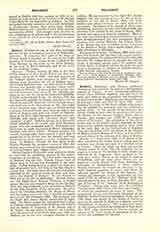

Ballarat, Diocese of, one of the three suffragan dioceses of the ecclesiastical province of Melbourne, Australia. It comprises that part of the State of Victoria which is bounded on the east by the 144th meridian E. longitude, thence by the Loddon to the River Murray; on the north by the River Murray; on the west by South Australia; and on the south by the Southern Ocean.
HISTORY.—Victoria (known till 1851 as the Port Phillip District of New South Wales) was first permanently colonized in 1835. The rich pastures of the Ballarat district were occupied in 1838. For thirteen years thereafter the site of Ballarat was a picturesque pastoral scene. In 1851 the Port Phillip District was formed into a separate colony under the name of Victoria. It was a period of severe commercial depression, and many of the colonists prepared to set out for the newly discovered goldfields of Ophir, in New South Wales. On June 29, 1851, the first profitable goldfield in Victoria was discovered at Clunes by James W. Esmond, an Irish Catholic miner, who had been on the Sacramento in ’49. The hopes of the colonists rose; ebbed again as Clunes proved a passing disappointment; then came in with a rush when, in August, rich gold was struck at Ballarat. Many of the little eight-feet-square claims were marvellously rich, lined with “jewelers’ shops” and “pockets” of gold. Ballarat became at a bound the richest goldfield in the world, and forty thousand people were soon encamped upon it. Rich fields were discovered in quick succession at Mount Alexander, Bendigo, and other places. Victoria became the modern Transylvania; there ensued a great rush of population to her shores; and she became, and long remained, the most populous of the Australian colonies. At Ballarat, through the lost battle of the Eureka Stockade the insurgent miners of 1854 ultimately won a victory over the exasperating old system of mining licences and “digger hunts”.
Bishop Goold of Melbourne made strenuous efforts to cope with the conditions created by the sudden expansion of population. The first priest appointed to Ballarat was the Rev. Patrick Dunne, most of whose flock in Coburg had stampeded to the gold-fields. Father Dunne lived in a calico hut, slept on a slab of gumtree bark, and had for his first church a canvas tent. For some years afterwards a few priests attended to the spiritual wants of what now comprises the Diocese of Ballarat. It was formed in 1874 out of the See of Melbourne. Its first bishop was the Right Rev. Michael O’Connor, a Dublin priest. He was consecrated in Rome on the 7th May, 1874, and was enthroned in his cathedral at Ballarat on the 20th December of the same year. He introduced the Christian Brothers, the Sisters of Mercy, and the Loreto nuns, and after a fruitful episcopate died on the 14th February, 1883. His successor was the Right Rev. James Moore, consecrated April 27, 1884. Dr. Moore opened the successful boys’ college at Ballarat, and introduced the Redemptorist Fathers and the Sisters of Nazareth, of St. Joseph, and of St. Brigid. He was skilled in finance, was a builder with big ideas, and at his death, 26th June, 1904, left Ballarat one of the best equipped dioceses in Australasia. He was succeeded by the Right Rev. Joseph Higgins, who was translated from the See of Rockhampton on the 3rd of March, 1905. He made mission- and school-extension the chief work of his episcopate. The Sisters of St. Joseph of Cluny were introduced; convents, primary and high schools, and churches (over twenty in two years to March, 1907) erected; and many new missions organized. Much of the work summarized here has been carried out in the once drought-scourged, but now prosperous, Mallee country; and remote Mildura, the Ultima Thule of the diocese, has now a resident priest, a convent of the Sisters of Mercy, and a parish school with a daily attendance of 130 pupils.
RELIGIOUS STATISTICS.—In March, 1907, there were: parochial districts, 29; churches, 145; secular priests, 62; regular priests, 10; religious brothers, 17; nuns, 230; convents, 18; college (boys), 1; superior day schools (boys) 2; boarding schools (girls), 10; superior day schools (girls), 9; primary schools, 57; home for aged poor, 1; orphanage, 1; children in Catholic schools, 4,900; Catholic population, 59,488.
HENRY W. CLEARY

